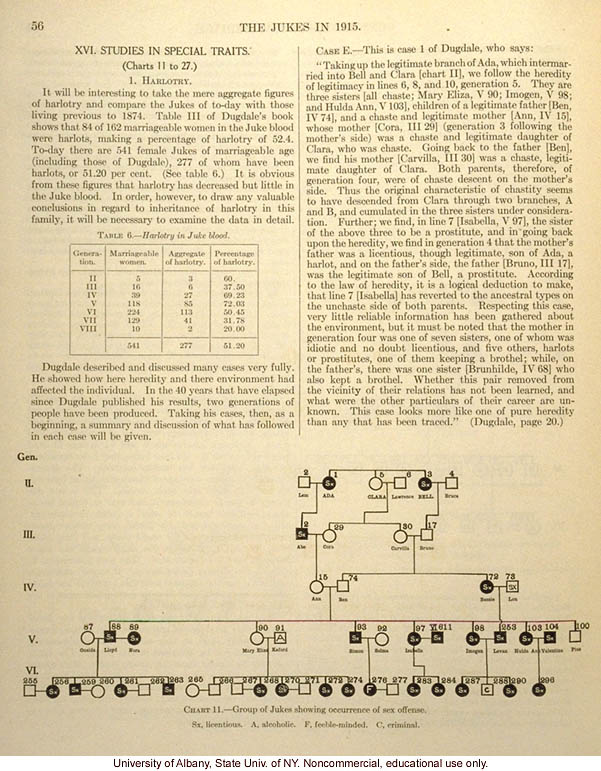56. The Jukes in 1915.
XVI. Studies in Special Traits.
(Charts 11 to 27).
1. Harlotry.
It will be interesting to take the mere aggregate figures of harlotry and compare the Jukes of to-day with those living previous to 1874. Table III of Dugdale's book show that 84 of 162 marriageable women in the Juke blood were harlots, making a percentage of harlotry of 52.4. To-day there are 541 female Jukes of marriageable age (including those of Dugdale), 277 of whom have been harlots, or 51.20 per cent. (See table 6.) It is obvious from these figures that harlotry has decreased but little in the Juke blood. In order, however, to draw any valuable conclusions in regard to inheritance of harlotry in this family, it will be necessary to examine the data in detail.
[tabular material]
Table 6. - Harlotry in Juke blood.
[end tabular material]
Dugdale described and detailed many cases very fully. He showed how here heredity and there environment had affected the individual. In the 40 years that have elapsed since Dugdale published his results, two generations of people have been produced. Taking his cases, then, as a beginning, a summary and discussion of what has followed in each case will be given.
Case E. - This is case 1 of Dugdale, who says:
"Taking up the legitimate branch of Ada, which intermarried into Bell and Clara, [chart II], we follow the heredity of legitimacy in lines 6, 8, and 10, generation 5. They are three sisters [all chaste; Mary Eliza, V 90; Imogen, V98; and Hulda Ann, V 103] children of a legitimate father [Ben, IV 74], and a chaste and legitimate mother [Ann, IV 15], whose mother [Cora, III 29] (generation 3 following the mother's side) was a chaste and legitimate daughter of Clara, who was chaste. Going back to the father [Ben], we find his mother [Carvilla, III 30] was a chaste, legitimate daughter of Clara. Both parents, therefore, of generation four, were of chaste descent on the mother's side. This the original characteristic of chastity seems to have descended from Clara through two branches, A and B, and cumulated in the three sisters under consideration. Further; we find, in line 7 [Isabella, V 97], the sister of the above to be a prostitute, and in going back upon the heredity, we find in generation 4 that the mother's father was a licentious, though legitimate, son of Ada, a harlot, and on the father's side, the father [Bruno, III 17], was the legitimate son of Bell, a prostitute. According to the law of heredity, it is a logical deduction to make, that line 7 [Isabella] has reverted to the ancestral types on the unchaste side of both parents. Respecting this case, very little reliable information has been gathered about the environment, but it must be noted that the mother in generation four was one of seven sisters, one of whom was idiotic and no doubt licentious, and five others, harlots or prostitutes, one of them keeping a brothel while, on the father's there was one sister [Brunhilde, IV 68] who also kept a brothel. Whether this pair removed from the vicinity of their relations has not been learned, and what were the other particulars of their career are unknown. This case looks more like one of pure heredity than any that has been traced." (Dugdale, page 20.)
[pedigree chart]
[caption] Chart 11. - Group of Jukes showing occurrence of sex offense.
Sx, licentious. A, alcoholic. F, feeble-minded. C, criminal.
[end]


